7 simple scarcity marketing tactics to supercharge ecommerce sales

Scarcity marketing taps into a simple principle: the scarcer something is, the more people value it. Find out how major ecommerce brands are using this principle to boost sales, attract new customers, and generate hype. And learn the 7 simple strategies you can use to make the most of scarcity marketing for your ecommerce store.
There are two simple tricks to growing your ecommerce sales by 200%. Both tricks will have an identical impact on your bottom line and keep customers happy in the exact same way, but you can only implement one.
The first trick is known and used by retailers everywhere. The second one’s an industry secret, with only five ecommerce brands in the world aware of it.
Which do you want to know?
If you’re like most people, you probably picked the second option. Now, I’ll come clean and say I don’t have two simple tricks that’ll double your sales. But this little exercise proves a simple fact that, when used right, can boost your sales: the scarcer something is, the more people value it.
This is called the scarcity principle, and it’s a near-universal truth. While both tricks were presented as having an identical impact on your business, you chose the scarce one. Something about it seemed more appealing. You wanted something not everyone could have. You wanted to join the exclusive group of in-the-know ecommerce brands.
When applied to marketing, this simple principle offers ecommerce brands a powerful tool to boost sales, attract customers, and generate hype and demand.
In this article we’ll define scarcity marketing, explore the psychology behind it, outline tips and tricks for applying it to ecommerce, and offer examples of how major brands use the scarcity principle to maximize sales.
Table of contents
Scarcity marketing is a strategy used by businesses to increase the perceived value of products by reducing supply. This can be done by reducing the supply of products (e.g., only 100 sneakers available), or by creating scarcity around offers on products (e.g., 40% off sneakers for one day only).
You’ve probably experienced scarcity marketing yourself. It’s at work when you:
- Check your inbox and see a flash sale and find yourself buying products you wouldn’t have bought otherwise
- Bid on eBay and spend more than you expected as the clock ticks down
- Sign-up for exclusive product drops
- Queue for a table at a crowded restaurant
- Pay price premiums for tickets to a sold-out concert
In all these instances, the perceived scarcity increases your sense of desire and urgency—it increases the value you assign to the good or service.
This is only natural, and you’re far from alone in this instinct. The desire for scarce goods and the aversion to missing out is a fundamental part of human psychology. When we see a limited opportunity, we get FOMO (fear of missing out), and we want it more than ever.
Using scarcity marketing, retailers make the most of this psychological quirk to drive higher sales, boost conversion rates, and generate hype around products and flash sales.
Product drops: release limited-inventory products
Releasing a limited number of products is the simplest form of scarcity marketing. It involves creating artificial scarcity in the production of products to boost the value of and demand for those products.
This technique is often used by sneaker brands. When Nike releases a new sneaker colorway and creates only 100,000 of them, they immediately generate hype around that shoe.
While their classic models have millions in circulation, the new design allows buyers to join an exclusive group of owners. And it’s this exclusivity that often leads these limited-edition products to quickly sell out.
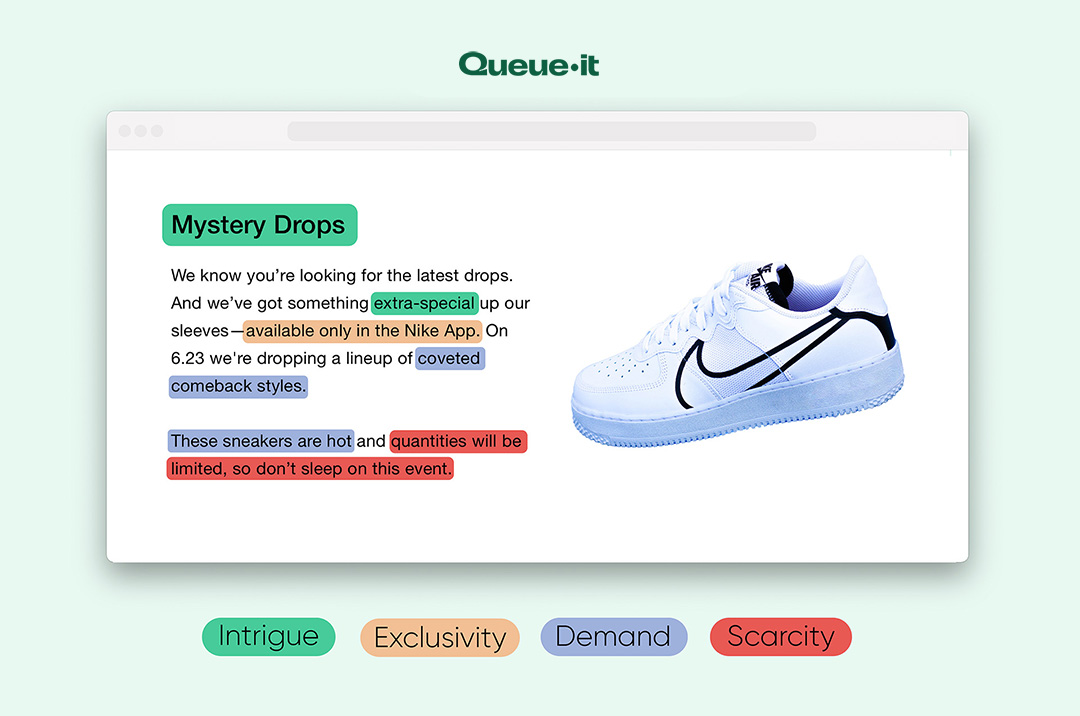
You might ask why Nike would release only 100,000 pairs of a sneaker when it’s obvious they could sell a million.
Well, the marketing effect of limited-inventory releases is two-pronged:
1. It generate hype around the specific product that’s being released
2. It draws attention to the brand, creating news headlines, hype, and new customer touchpoints.
Just like half of the struggle for brick-and-mortar shops is getting people into the store, half of the ecommerce struggle is getting people onto the website.
People on the Nike site who missed out on a pair of limited-release sneakers are far more likely to buy something else than customers who aren’t engaged with the brand at all. And customers who see shoes selling on the secondary market for 500% markups take notice of the brand that’s creating such hype.
The scarcity marketing of the limited inventory product is not just about the product itself. It’s about creating connections with customers and building a perception of your brand as in-demand.
RELATED: Everything You Need to Know About Product Drops: Strategies, Benefits & Examples
Flash sales: Run time-limited sales
Most brands can’t generate hype around a limited-release product like Nike can. But this doesn’t stop them from taking advantage of the power of scarcity marketing.
How?
Flash sales, or time-limited sales, create scarcity not surrounding the product, but surrounding the deals offered to customers. This is a powerful tool as it creates a “don’t miss out” effect. Customers with some intent to purchase a product are often tipped over the edge by flash sales.
This effect is why Black Friday and Singles’ Day are the biggest retail days of the year. It’s why Prime Day has crashed Amazon’s website multiple times. The products may be abundant, but the deals are limited to one special day—and this drives customers to spend big.
RELATED: The Power of Anticipation Psychology & How to Use It for Ecommerce Marketing
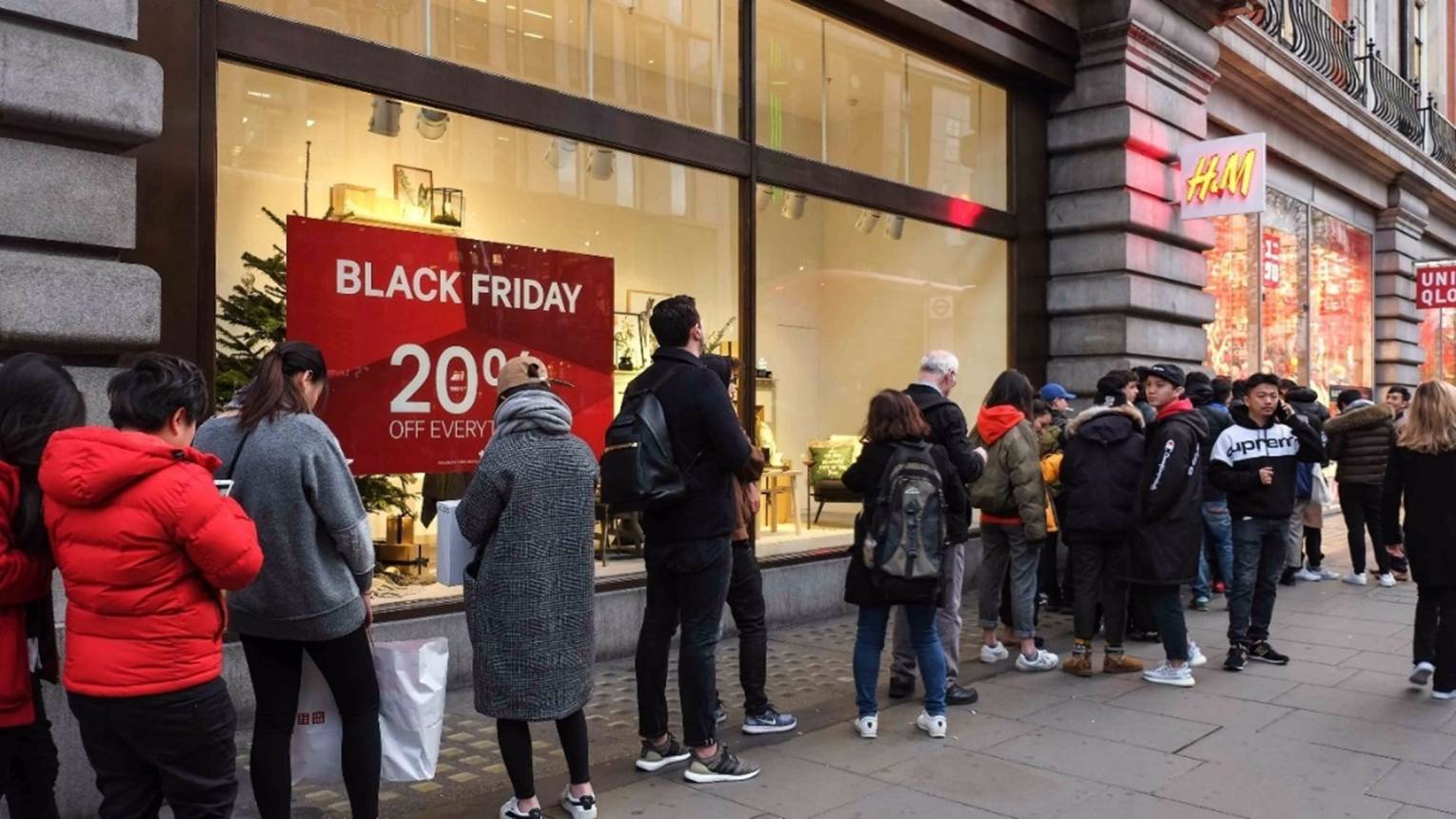
German supermarket giant Lidl is an unlikely candidate for the most hyped sneaker release of 2021. But when they announced their limited-edition $16 sneakers and told shoppers that there would only be about 50 available at each store, chaos ensued.
Lines stretched outside Lidl stores, shoes resold for over $6,000 on eBay, and countless headlines were written about the sneakers.
One morning I was heading to Lidl to buy groceries and was confronted with one of these long lines. I asked the person in front of me what was going on, then after some Googling, discovered how rare the sneakers were and joined the queue to buy a pair.
I didn’t need new sneakers. I wasn’t a huge fan of the design. But as the door opened, I joined the feverish crowd rushing to the special buys section to fight for my own pair of the exclusive Lidl sneakers.
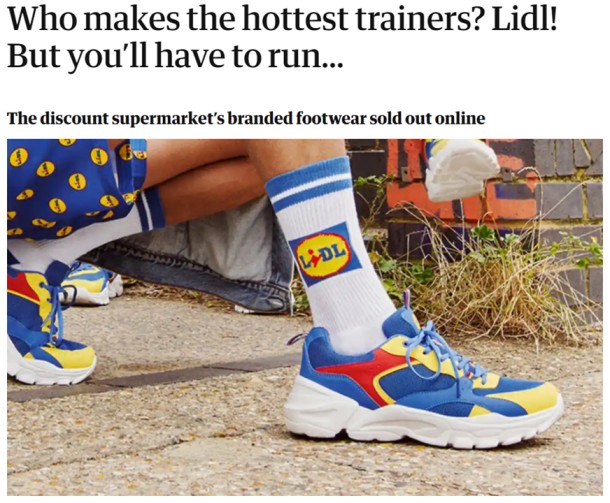
As I walked home with the shoes, I was confused. What had happened? Why did I buy sneakers I didn’t want or need?
I realized I got caught up in the scarcity marketing tactic that has made German supermarkets Lidl and Aldi global sensations.
Along with their regular groceries, which are always in stock, these supermarkets release their weekly “special buys”. Invariably, these are limited-inventory products, and customers don’t know when or if the items will ever return to stores.
Every week, millions of customers head to Lidls and Aldis across the world to snatch up special buys. And every week, these supermarkets create new touchpoints with customers and generate new discussions around their brands.
As with the Nike example above, the special buys bring customers into Aldi and Lidl stores. And getting customers there is half the battle. After all, who goes to a supermarket without grabbing a few groceries?
People come for the scarce special buys, but they stay for the low prices and great products.
It’s not just sneakers that enjoy the “special buys” scarcity marketing hype. Each Christmas, Aldi releases Kevin the Carrot plush toys to stores around the world, and customers go crazy for them. 75,000 Aldi shoppers queued in a virtual waiting room hoping to get their hands on a Kevin the Carrot toy. The magic of scarcity marketing at work.

These supermarkets have integrated scarcity marketing into the core of their business models, and they’ve grown rapidly as a result.
1. Frame scarcity as a result of demand
Scarcity marketing is at its most powerful when combined with another influential marketing tactic: social proof.
While scarcity marketing is all about showing supply is low, social proof is about showing demand is high. Combined, these two effects create competition for products.
This sense of competition supercharges customers' desire for the products, says Dr. Robert Cialdini in his best-seller Influence:
“This finding highlights the importance of competition in the pursuit of limited resources. Not only do we want the same item more when it is scarce, we want it most when we are in competition for it.”
This power of scarcity combined with social proof can be seen among gaming consoles and graphics cards—products that’ve been hit hard by supply chain shortages. While the scarcity may not be intentional, it’s helped PS5s and AMD graphics cards become the some of the most hyped and in-demand products of the past two years.
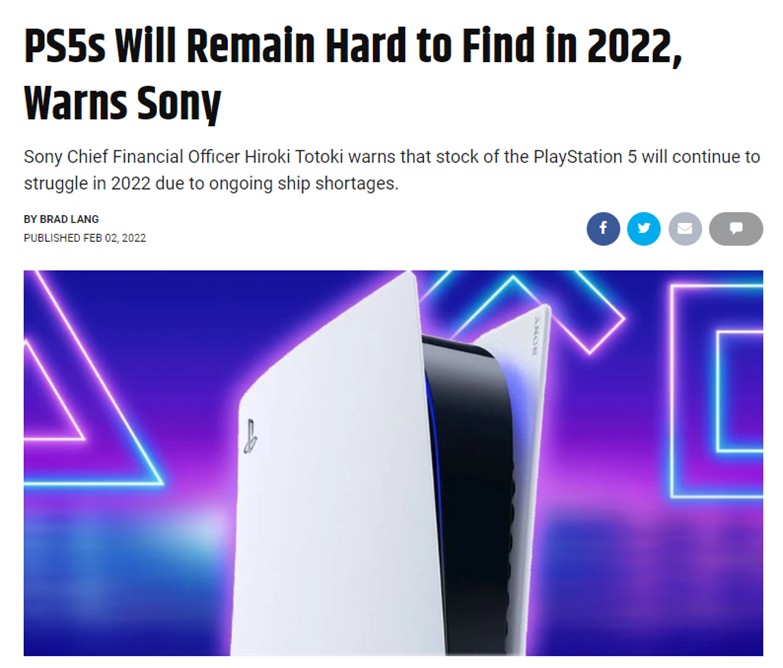
When you’re implementing scarcity marketing, keep competition framing in mind. It’ll maximize the impact of your marketing strategy by combining the power of scarcity with the magic of social proof. Check out the examples below to see how you can incorporate competition framing into your scarcity marketing strategy.
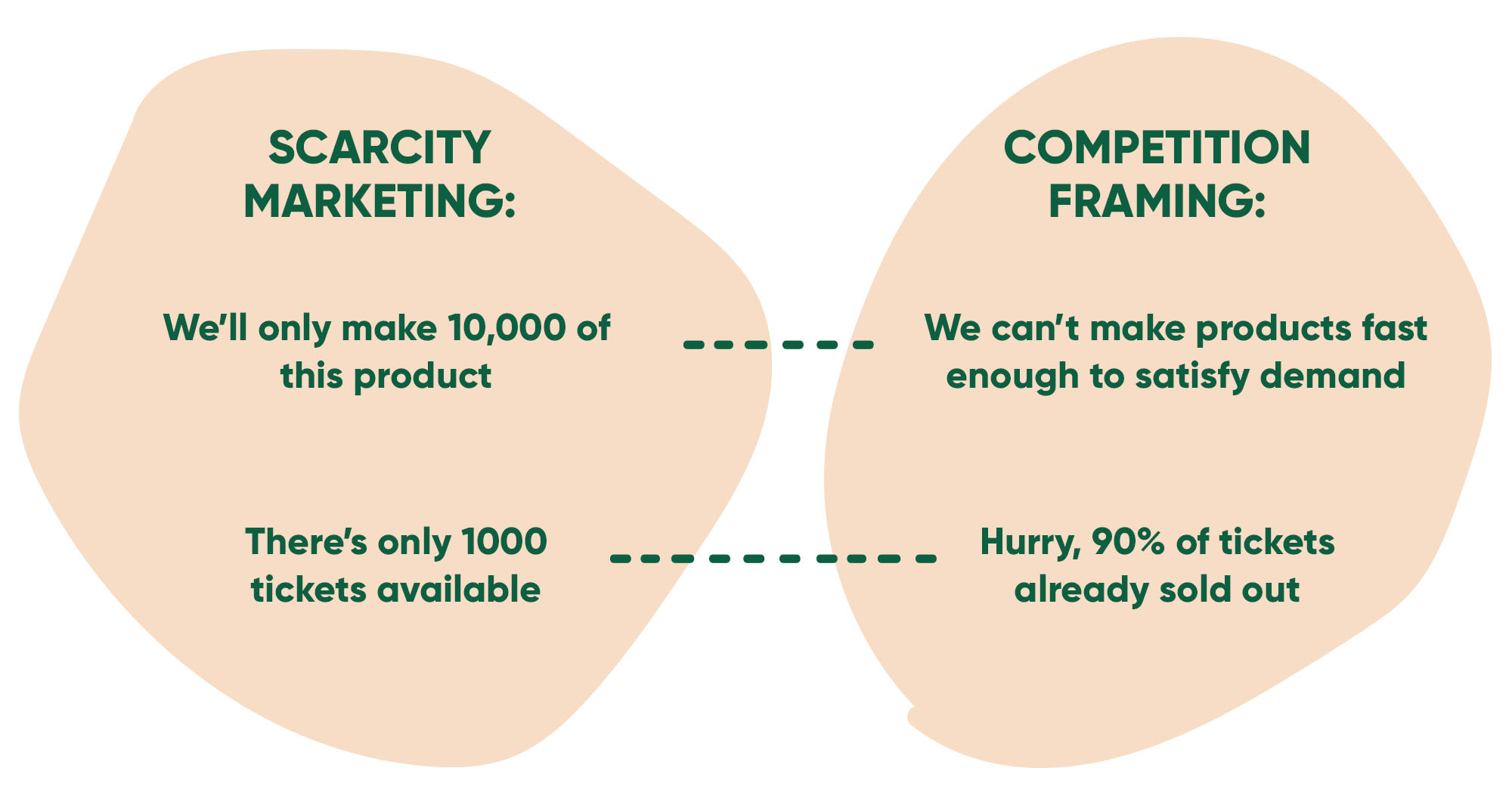
2. Use numbers to foreground ecommerce scarcity
One of the best ways to foreground scarcity and social proof in ecommerce is by showing numbers. With a keen eye, you’ll notice numbers like these across ecommerce sites everywhere:
- “4 items left in stock”
- “6 people viewing this item”
- “This item is in 12 people’s carts”
- “9 purchased in the last hour”
- “2 hours left on this deal”
Placing specific numbers on ecommerce product pages allows retailers to recreate the scarcity and social proof effects seen in brick-and-mortar stores. Dozens of people grabbing an item off the shelf is a surefire way to capture a customer’s attention. And when there’s only a couple items left and FOMO kicks in, customers are more likely to convert than ever.


It’s important when using this strategy to be honest about numbers. There’s a store near me that’s had a “closing down sale” for almost a year now. While the sale started with people flooding the store to check out their deals, it’s now increasingly empty, as people have realized it’s just a ploy to trick them into buying.
The same applies to ecommerce. Customers won’t trust a brand that tells them every item on the site is the last one in stock. They’ll be dismayed if they see items remain on sale weeks after you told them it was their last chance. While you may want to convert customers on the spot, using scarcity marketing to deceive them isn't worth the threat to the customer experience.
RELATED: Boost Your Ecommerce Customer Experience with These 9 CX Tips & Tricks
3. Create invite-only sales & services
Gmail email addresses are everywhere today. But this wasn’t always the case. In fact, for the first 3 years of Gmail, users could only get the coveted @gmail.com address by invitation. Invites were in such high demand that users paid up to $200 to buy them on eBay.
This is the story of many of the world’s largest tech services. Spotify, Facebook, Pinterest, Quora—they all began as invite-only. And for each of them, demand for invites to their services soared before they were released to the wider public.
Using the invite-only strategy for flash sales or product drops creates the sense of exclusivity that’s at the core of scarcity marketing. And ecommerce businesses can leverage this to reward loyal customers and boost conversion rates by offering exclusive first-access.
RELATED: Roll Out the Red Carpet for Loyal Customers with Exclusive Invite-only Sales & Drops
4. Offer daily deals
A simple way to incorporate scarcity marketing into your ecommerce store is to implement daily or weekly deals into your site. This can be done by selling items that are available for one day only, or by selling a few new products each day for a great discount.
Even if you sell these products at cost, or at a loss, daily deals tap into scarcity marketing by encouraging customers to sign up for mailing lists or check your site daily to ensure they don’t miss out on a bargain.
You’ll find this strategy used by major ecommerce sites like Amazon and Best Buy. And it’s the core business model for Swiss ecommerce store QoQa, who you can hear from below.

5. Create seasonal products
One of Starbucks' most famous beverages is only available for a limited time each year. This drink, the Pumpkin Spice Latte (PSL), was estimated to be responsible for $100 million of Starbucks’ 2015 revenue, and in 2021, the release of the PSL was responsible for a 10% week over week increase in sales.
Writing in Forbes about the Pumpkin Spice phenomenon, Debra Dosnton-Miller says:
“Products that are available only for a limited time have a kind of built-in marketing that can grow in impact over time.”
Seasonal products like these are a great way to create time scarcity for customers.
British equestrian brand LeMieux recognized this fact, and each Black Friday offer their customer’s favorite products in limited-edition styles and colors. These special-release products create such demand that LeMieux had to implement a virtual waiting room just to control the traffic. What’s more, virtual waiting rooms have their own scarcity marketing benefits, as you’ll see below.
6. Implement a virtual waiting room
Virtual waiting rooms allow ecommerce retailers to show off social proof and scarcity during product launches or flash sales. When implemented, customers who enter a product launch or sale are redirected into a branded waiting room where they can see exactly how many people are waiting to enter the sale alongside them.
This allows ecommerce retailers to mimic the social proof that's usually created by real-world queues, which have been shown to increase conversions and order value. They help ecommerce retailers achieve two of the key scarcity marketing strategies described above: framing scarcity as a result of demand, and using numbers to show customers the true demand for and supply of products.
Virtual waiting rooms show off the demand for products and tap into customers’ fear of missing out, assuring them they’re in good company when choosing you as a retailer.
RELATED: Why Smart Marketers are Putting Their Shoppers in an Online Queue
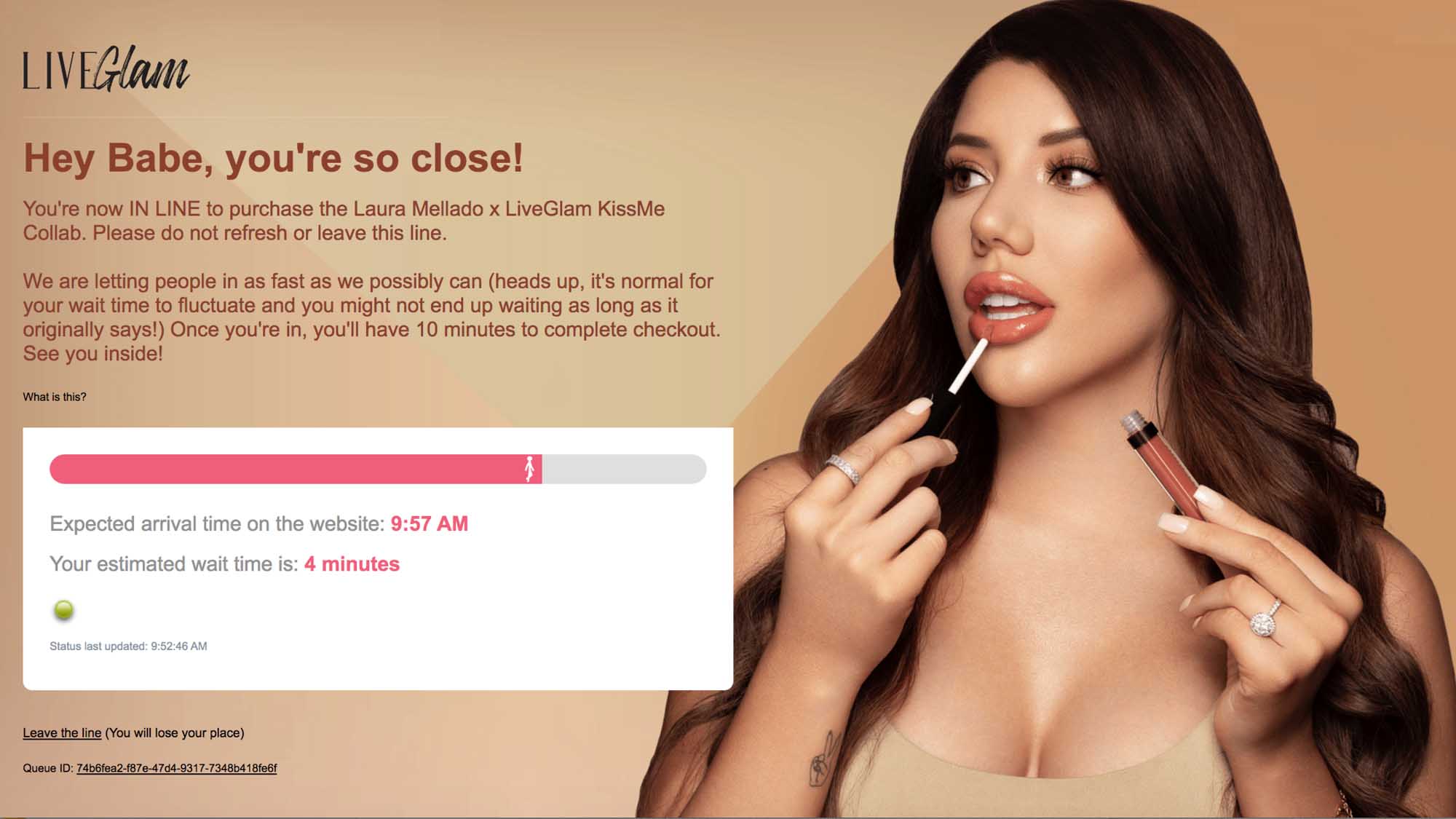
7. Create product 'editions'
The natural pushback to scarcity marketing is the idea that retailers would place limits on the amount of products they sell, and in turn the amount of customers they can reach.
One way to tap into scarcity marketing without sacrificing total sales is to release products in multiple editions.
A first edition copy of Charles Dickens’ A Christmas Carol sold for $500,000. Meanwhile, I can buy the paperback for $6 on Amazon. A first edition Pokémon card will set you back up to $900,000, while you can grab a pack online for $8.
What’s the key difference between the first edition book or card and its current iteration? The first editions are scarce. There’s a finite number that can or will ever exist.
Creating product “editions” may be difficult to implement into your own product releases, but there’s an appetite for scarce, rare, and collectible goods.
This appetite is perhaps most evident in the recent boom of NFTs—a technology that puts scarcity and rarity at its core. NFT company Bored Ape Yacht Club (BAYC) created 10,000 of their original Bored Ape NFTs. These are the only originals that can or will ever exist, and they’ve skyrocketed in value on the secondary market from an original price of $200 to highs of $2.3 million.
In the meantime, the BAYC creators have released new editions and iterations of these NFTs, all of which quickly sold out at increasingly high prices. The scarcity of the original NFTs helped them soar in value and opened the doors for the creators to leverage this hype for future sales.
The same effect occurs for re-releases of vintage sneakers. The highly popular and incredibly scarce original 1984 Jordan “Bred” 1 sneakers currently fetch up to $20,000 on the resale market. These shoes have been re-released twice, selling out fast both times. Each new iteration draws on the scarcity of the original sneaker to drive hype surrounding it's re-release. The original shoes maintain their scarcity value, and the new versions continue to drive sales for Nike. It's a scarcity marketing win-win.

Source: City Blue Shop
Tap into a scarcity marketing strategy for your ecommerce store
Scarcity has always been explicit in the real world. It’s obvious when shelves are almost empty, when there’s a crowd around a product or a queue outside a store, or when restaurants are turning away customers because they’re so busy.
But in the world of ecommerce, many brands lose out on the powerful lever of influence that is scarcity. The scarcity marketing strategies outlined in this article offer opportunities for ecommerce stores to make the most of the scarcity principle.
Major brands like Amazon, Nike, Lidl, and Starbucks, have scarcity marketing embedded into their businesses. And while it may not be the simple trick to doubling your revenue offered at the beginning of this article, scarcity marketing has huge potential for increasing conversions, attracting new customers, and generating hype.